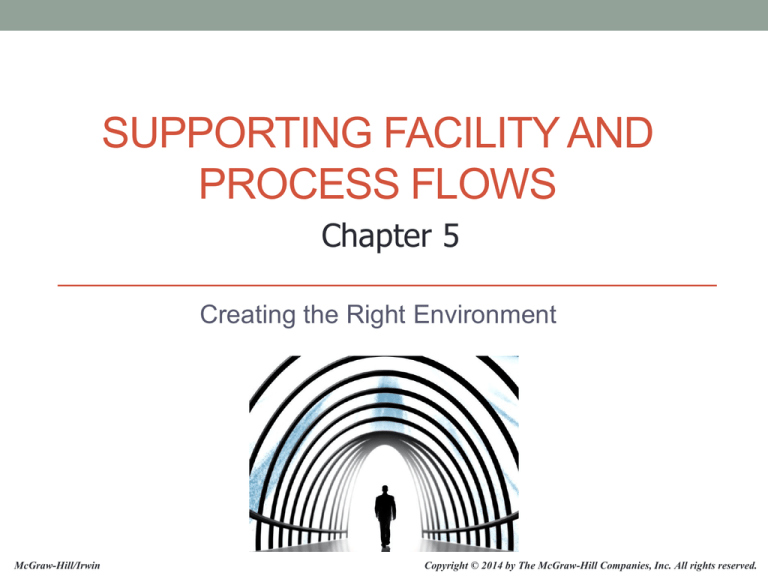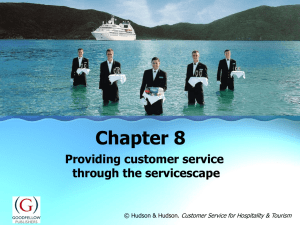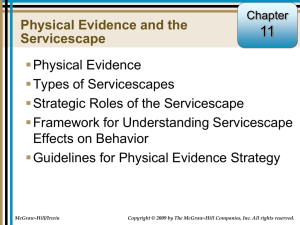
SUPPORTING FACILITY AND
PROCESS FLOWS
Chapter 5
Creating the Right Environment
McGraw-Hill/Irwin
Copyright © 2014 by The McGraw-Hill Companies, Inc. All rights reserved.
Learning Objectives
• Describe the impact of “servicescapes” on behavior of customers
•
•
•
•
•
•
and employees.
Identify and discuss environmental dimensions of servicescapes.
Identify critical design features of a service supporting facility.
Draw a swim lane flowchart, process flow diagram, and a Gantt
chart of a service process.
Calculate performance metrics such as throughput time and direct
labor utilization.
Identify bottleneck operation in a product layout and regroup
activities to create new jobs that will increase the overall service
capacity.
Use operations sequence analysis to determine relative locations
of departments in a process layout that minimize total flowdistance.
5-2
Environmental Orientation Considerations
• Spatial cues are needed to orient visitors.
• Formula facilities draw on previous experience.
• Entrance atrium allows visitors to gain a quick orientation
and observe others for behavioral cues.
• Orientation aids and signage such as “You Are Here”
maps reduce anxiety.
5-3
Servicescapes
Designing Physical Surroundings to Affect
Employee and Customer Behavior
• Ambient Conditions: background characteristics
such as noise level, music, lighting, temperature,
and scent
• Spatial Layout and Functionality: reception area,
circulation paths of employees and customers,
and focal points
• Signs, Symbols, and Artifacts: selection,
orientation, location, and size of objects
5-4
Servicescape Elements
5-5
Typology of Servicescapes
Who Performs in
Servicescape
Physical Complexity of the Servicescape
Elaborate
Lean
Self-service
(customer only)
Golf course
Water slide park
Post office kiosk
E-commerce
Interpersonal
(both)
Luxury hotel
Airline terminal
Budget hotel
Bus station
Remote service
(employee only)
Research lab
L.L. Bean
Telemarketing
Online tech support
5-6
Facility Design Considerations
• Nature and Objectives of Service Organization
• Land Availability and Space requirements
• Flexibility
• Security
• Aesthetic Factors
• The Community and Environment
5-7
Types of Services Processes
Process
Type
Service
Example
Characteristic
Management
Challenge
Project
Consulting
One-of-a-kind
engagement
Staffing and
scheduling
Job Shop
Hospital
Many specialized
departments
Balancing utilization
and scheduling
patients
Batch
Airline
Group of customers
treated simultaneously
Pricing of perishable
asset (seat inventory)
Flow
Cafeteria
Fixed sequence of
operations
Adjust staffing to
demand fluctuations
Continuous
Electric
Utility
Uninterrupted delivery
Maintenance and
capacity planning
5-8
Swim Lane Flowchart of Graduate School
Admissions
5-9
Gantt Chart for Mortgage Service
5-10
Process Analysis Terminology
• Cycle Time is the average time between
completions of successive units.
• Bottleneck is the factor that limits production
usually the slowest operation.
• Capacity is a measure of output per unit time
when fully busy.
• Capacity Utilization is a measure of how much
output is actually achieved.
• Throughput Time is the time to complete a
process from time of arrival to time of exit.
5-11
Process Analysis Terminology (cont.)
• Rush Order Flow Time is the time to go through
the system without any queue time.
• Direct Labor Content is the actual amount of work
time consumed.
• Total Direct Labor Content is the sum of all the
operations times.
• Direct Labor Utilization is a measure of the
percentage of time that workers are actually
contributing value to the service.
5-12
Process Flow Diagram of Mortgage
Services
5-13
Product Layout:
Work Allocation Problem
5-14
Automobile Driver’s License Office
(Improved Layout)
5-15
DMV Office (Flexible Layout)
5-16
Process Layout: Ocean World Theme
Park
5-17
Process Layout:
Relative Location Problem
Ocean World Theme Park Daily Flows
A
A
B
7
8
C
D
E
F
20
0
5
6
6
10
0
2
15
7
8
10
3
B
C
10
6
D
0
30
5
E
10
10
1
20
F
0
6
0
3
Flow matrix
A
Net
flow
B
C
D
E
15
30
0
15
6
12
40
10
8
20
8
8
30
6
6
F
10
4
Triangularized matrix
Description of attractions: A=killer whale, B=sea lions, C=dolphins, D=water skiing,
E=aquarium, F=water rides.
5-18
Ocean World Theme Park (Proposed
Layout)
(a)
A
D
Initial layout
B
E
C
F
(b) Move C close to A
C
Pair Flow distances
AC
30 x 2 = 60
AF
6 x 2 = 12
DC
20 x 2 = 40
DF
6 x 2 = 12
Total
124
(c ) Exchange A and C
Pair Flow distances
A
AE
15 x 2 = 30
C B
CF
8 x 2 = 16
AF
6 x 2 = 12
D E
F
AD
0x2= 0
DF
6 x 2 = 12
Total
70
Pair Flow distances
CD
20 x 2 =40
D E
F
CF
8 x 2 =16
DF
6 x 2 = 12
AF
6 x 2 = 12
CE
8 x 2 = 16
Total
96
(d) Exchange B and E and move F
Pair Flow distances
A
F
AB
15 x 2 = 30
AD
0x2= 0
C
E
FB
8 x 2 = 16
D
B
FD
6 x 2 = 12
Total
58
A
B
5-19
Health Maintenance Organization (A)
A
B
C
D
E
F
Reception
A
-
30
0
5
0
0
Waiting room
B
10
-
40
10
0
0
Examination
C
15
20
1
15
5
5
Laboratory
D
5
18
8
-
6
3
X-ray
E
0
4
1
2
-
4
Minor surgery
F
2
0
0
0
1
5-20
HMO (A) Questions
1.
2.
Beginning with a good initial layout, use operations
sequence analysis to determine a better layout that
would minimize the walking distance between different
areas of the clinic.
Defend your final layout based on features other than
minimizing
walking distance.
5-21
Health Maintenance Organization (B)
Activity
Receive prescriptions
Type labels
Time (sec.)
24
120
Fill prescriptions
60
Check prescriptions
40
Dispense prescriptions
30
5-22
HMO (B) Questions
1.
2.
Identify the bottleneck activity, and show how capacity
can be increased by using only two pharmacists and
two technicians.
In addition to savings on personnel costs, what
benefits does this arrangement have?
5-23
Esquire Department Store
1.
2.
3.
Use CRAFT logic to develop a layout that will
maximize customer time in the store.
What percentage increase in customer time
spent in the store is achieved by the
proposed layout?
What other consumer behavior concepts
should be considered in the relative location of
departments?
5-24
The Role of the Servicescape
5-25
The Servicescape
Concept: a modern farmer’s market for the discerning
customer
• Aesthetics
• Force Flow
• Queuing
• Results
“We want to change the way people eat…” Brian Cronin, General Manager
5-26
Aesthetics
5-27
Force Flow
5-28
Normal Grocery Store
Dairy
Meat
Frozen
Produce
Grocery & Staples
Cashiers
Deli
5-29
Comparison
Central Market
60k ft2
Average Grocery Store
Size
100k ft2
Transactions / Week
25,000
$40
Wine
50,000
Sales / Customer
Product Mix
$20
Groceries
5-30
“There’s cheese at the end of the maze…”
Questions
1. How do the environmental dimensions of the
servicescape (ambient conditions,
space/function, signs, symbols & artifacts)
explain the success of Central Market?
2. Comment on how the servicescape shapes the
behaviors of both customers and employees.
5-31
Topics for Discussion
• Compare the attention to aesthetics in waiting rooms that you
•
•
•
•
have visited. How did the different environments affect your
mood?
Give an example of a servicescape that supports the service
concept and another that detracts. Explain the success or failure
in terms of the servicescape dimensions
Select a service and discuss how the design and layout of the
facility meets the five factors of nature and objectives of the
organization.
For Example 5.3, the Ocean World theme park, make an
argument for not locating popular attractions next to each other.
The CRAFT program is an example of a heuristic programming
approach to problem solving. Why might CRAFT not find the
optimal solution to a layout problem?
5-32
Interactive Exercise
The class divides into small groups
• One-half of the groups produce examples based
on work experience with supportive
servicescapes in terms of job satisfaction
and productivity.
• The other one-half of the groups provide
examples of poor servicescapes in terms of job
satisfaction and productivity.
5-33







